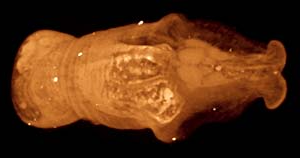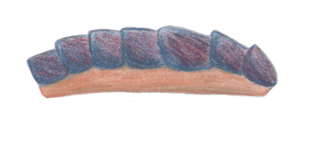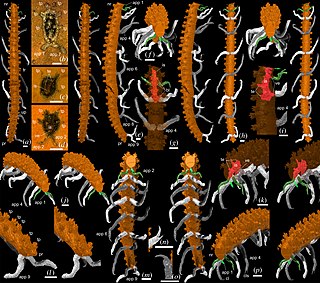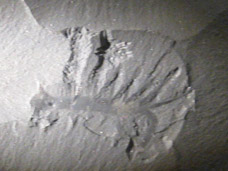
Hallucigenia is a genus of Cambrian animal resembling worms, known from articulated fossils in Burgess Shale-type deposits in Canada and China, and from isolated spines around the world. The generic name reflects the type species' unusual appearance and eccentric history of study; when it was erected as a genus, H. sparsa was reconstructed as an enigmatic animal upside down and back to front. Hallucigenia is later recognized as part of lobopodians, a grade of Paleozoic panarthropods where the velvet worms, water bears, and arthropods arose.

Wiwaxia is a genus of soft-bodied animals that were covered in carbonaceous scales and spines that protected it from predators. Wiwaxia fossils – mainly isolated scales, but sometimes complete, articulated fossils – are known from early Cambrian and middle Cambrian fossil deposits across the globe. The living animal would have measured up to 5 cm (2 inch) when fully grown, although a range of juvenile specimens are known, the smallest being 2 millimetres (0.079 in) long.

Aplacophora is a presumably paraphyletic taxon. This is a class of small, deep-water, exclusively benthic, marine molluscs found in all oceans of the world.
The Silurian Lagerstätte preserved in the limestone Wenlock Series of Herefordshire, England, offers paleontologists a rare snapshot of a moment in time, about 420 Mya. In the formation, layers of fine-grained volcanic ash punctuate a sequence of carbonate muds that were accumulating in a marine environment on the outer continental shelf. In this fine-grained matrix, soft-bodied animals and delicate, lightly sclerotized chitinous shells are often preserved in three dimensions, as calcitic fossilizations within calcareous nodules. Calcitic fossilization is an unusual feature.
Heloplax is a genus of worm-like molluscs. Its soft parts are preserved in three dimensions in the Silurian Herefordshire Lagerstatte; its disarticulated valves are known from other Silurian deposits. It is very bizarre by modern standards; it bears serially repeated units, and has spines. It probably falls somewhere between the aplacophorans and polyplacophora; its valves were composed of aragonite

Diania is an extinct genus of lobopodian animal found in the Lower Cambrian Maotianshan shale of China, represented by a single species D. cactiformis. Known during its investigation by the nickname "walking cactus", this organism belongs to a group known as the armoured lobopodians and has a simple worm-like body with robust, spiny legs. Initially, the legs were thought to have jointed exoskeleton and Diania was suggested to be close to the origins of arthropods, but many later studies have denied this interpretation.
The Heloplacidae are a group of plated aplacophora known from Silurian deposits. Their best understood representative, Acaenoplax, can be taken as representative of the family; it is the only genus for which soft part anatomy is known.

Kulindroplax perissokomos is a Silurian mollusk, known from a single fossil from the Coalbrookdale Formation fauna of England. It lived during the Homerian Age. It is considered a basal aplacophoran. Unlike all modern aplacophorans, which are shell-less, Kulindroplax has a chiton-like shell, and it is considered a transitional fossil in the evolution of molluscs.
Phthipodochiton is an extinct genus of molluscs, known from several fossils from the upper Ordovician fauna of the Lady Burn Starfish beds of Girvan, Scotland. It shows a mixture of aplacophoran body plan and polyplacophoran-like valves, and it is an informative fossil in the evolution of aculiferan mollusks.
Pauline avibella is a fossil ostracod from the Silurian with unusually well preserved soft parts, including limbs, eyes, gills and alimentary system.
Pauline is a fossil genus of ostracods from the Silurian. Genus contains two species: Pauline avibella found in 425-million-year-old rocks in the Herefordshire Lagerstätte in England near the Welsh Border and Pauline nivisis, known from the Lower Silurian Pentamerus Bjerge Formation of north Greenland.
Kenostrychus is a monospecific genus of polychaete worms known from exceptional 3D fossils from the Silurian Herefordshire lagerstatten.

Invavita piratica is an extinct, parasitic species of tongue worm, provisionally assigned to the order Cephalobaenida, from Herefordshire Lagerstätte, Ludlow-aged England. Despite the common name, tongue worms are actually highly modified crustacean arthropods closely related to barnacles and copepods, not worms; the Pentastomida are obligate parasites. It possessed a head, a worm-like body, and two pairs of limbs.

Offacolus is an extinct genus of euchelicerate, a group of chelicerate arthropods. Its only species, O. kingi, has been found in deposits from the Silurian period in the Wenlock Series Lagerstätte of Herefordshire, England. It is the only member of the monotypic family Offacolidae, and classified as a basal ("primitive") genus in the clade Euchelicerata, along with Dibasterium and Prosomapoda. The genus is named after Offa, a king from the ancient kingdom of Mercia, and colus, a person who dwelled among the Offa's Dyke. The species name honors Robert Joseph King, a British mineralogist who found the fossils of Offacolus.
Sollasina is an extinct genus of ophiocistioid that is known from Silurian to Devonian.
The Waukesha Biota refers to the biotic assemblage of the Konservat-Lagerstätte of Early Silurian age within the Brandon Bridge Formation in Waukesha County and Franklin, Milwaukee County, Wisconsin. It is known for the exceptional preservation of its diverse, soft-bodied and lightly skeletonized taxa, including many major taxa found nowhere else in strata of similar age. The sites discovery was announced in 1985, thus leading to a wide plethora of discoveries being made.

Thanahita is a genus of extinct lobopodian and known from the middle Silurian Herefordshire Lagerstätte at the England–Wales border in UK. It is monotypic and contains one species, Thanahita distos. Discovered in 2018, it is estimated to have lived around 430 million years ago and is the only known extinct lobopodian in Europe, and the first Silurian lobopodian known worldwide.

Hallucigeniidae is a family of extinct worms belonging to the group Lobopodia that originated during the Cambrian explosion. It is based on the species Hallucigenia sparsa, the fossil of which was discovered by Charles Doolittle Walcott in 1911 from the Burgess Shale of British Columbia. The name Hallucigenia was created by Simon Conway Morris in 1977, from which the family was erected after discoveries of other hallucigeniid worms from other parts of the world. Classification of these lobopods and their retatives are still controversial, and the family consists of at least four genera.

Coalbrookdale Formation, earlier known as Wenlock Shale or Wenlock Shale Formation and also referred to as Herefordshire Lagerstätte in palaeontology, is a fossil-rich deposit (Konservat-Lagerstätte) in Powys and Herefordshire at the England–Wales border in UK. It belongs to the Wenlock Series of the Silurian Period within the Homerian Age. It is known for its well-preserved fossils of various invertebrate animals many of which are in their three-dimensional structures. Some of the fossils are regarded as earliest evidences and evolutionary origin of some of the major groups of modern animals.
Carbotubulus is a genus of extinct worm belonging to the group Lobopodia and known from the Carboniferous Carbondale Formation of the Mazon Creek area in Illinois, US. A monotypic genus, it contains one species Carbotubulus waloszeki. It was discovered and described by Joachim T. Haug, Georg Mayer, Carolin Haug, and Derek E.G. Briggs in 2012. With an age of about 300 million years, it is the first long-legged lobopodian discovered after the period of Cambrian explosion.







